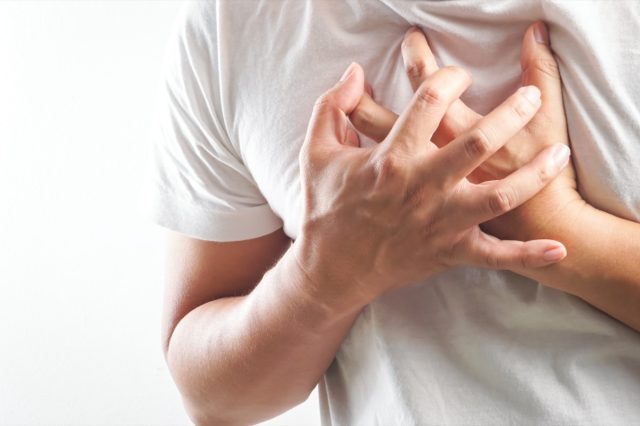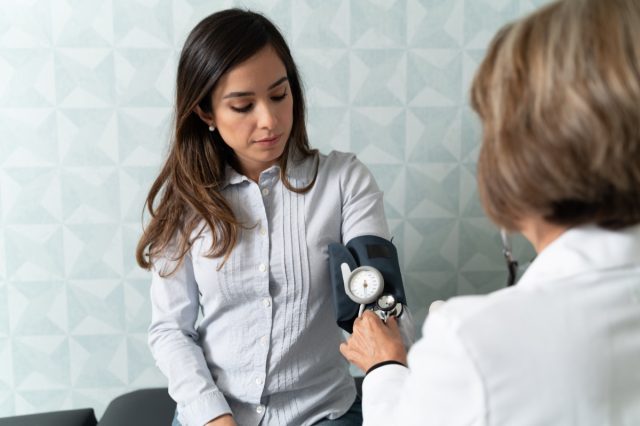

Dr. Dlott explains, “The term ‘heart disease’ refers to several types of heart conditions. The most common type of heart disease in the United States is coronary artery disease (CAD), which affects the blood flow to the heart. Decreased blood flow can cause a heart attack.”
RELATED: I’m a Doctor and Here’s the #1 Sign You are Obese


A sign of heart disease is pain in the arm. According to Dr. Dlott, “The reason for the pain in the arm is that the nerves that carry signals from the heart to the brain and those that do the same thing for the arm both send their signals to the same brain cells. Because of this, the brain may get confused about the source of the signal and this can often result in the pain from heart disease and heart attacks being felt as pain in the arm with no sensation of pain in the chest.”
RELATED: This Common Habit Makes Your Dementia Risk Soar


Dr. Dlott says, “As the condition progresses and the arteries become narrower the body has to work harder to deliver blood to vital organs, such as the heart. Angina can occur when not enough oxygen-rich blood reaches the heart which often results in people breaking out in a cold sweat.”
RELATED: I’m a Doctor and Here’s the #1 Sign You Have Visceral Fat


“Symptoms will vary depending on the specific condition,” Dr. Dlott states. “Some conditions, such as type2 diabetes or hypertension, may initially cause no symptoms at all. However, typical symptoms of an underlying cardiovascular issue include: Pain or pressure in the chest, which may indicate angina; Pain or discomfort in the arms, left shoulder, elbows, jaw or back; Shortness of breath; Nausea and fatigue; Lightheadedness or dizziness; Cold sweats. Although these are the most common ones, cardiovascular disease can cause symptoms anywhere in the body.”
RELATED: I’m a Doctor and Here’s the #1 Sign You Have Cancer


Dr. Dlott explains, “Some risk factors for heart disease cannot be controlled, such as your age or family history. But you can take steps to lower your risk by changing the factors you can control. Eating a diet high in saturated fats, trans fat, and cholesterol has been linked to heart disease and related conditions, such as atherosclerosis. Also, too much salt (sodium) in the diet can raise blood pressure. Not getting enough physical activity can lead to heart disease. It can also increase the chances of having other medical conditions that are risk factors, including obesity, high blood pressure, high cholesterol, and diabetes. Regular physical activity can lower your risk for heart disease. Drinking too much alcohol can raise blood pressure levels and the risk for heart disease. It also increases levels of triglycerides, a fatty substance in the blood which can increase the risk for heart disease. Taking a Cholesterol Test Panel can help evaluate the health of your heart and arteries and the results can be an important part of evaluating your overall health. The panel measures lipids: LDL (bad) cholesterol, HDL (good) cholesterol, and triglycerides (the fat in blood). High lipid levels usually have no symptoms, and some people can have high lipid levels for years without knowing it.”
RELATED: Expert Shares Tips for Reversing Your Diabetes


“High blood pressure, high blood cholesterol and smoking are key risk factors for heart disease,” Dr. Dlott says. “About half of the people in the United States (47%) have at least one of these three risk factors. Several other medical conditions and lifestyle choices can also put people at a higher risk for heart disease include: Diabetes; Overweight and obesity; Unhealthy diet; Physical inactivity; Excessive alcohol use. Taking a Basic Health Profile test, like one from Quest Diagnostics, is a great place to start if you want to gain insight into your overall health. This test helps identify health conditions ranging from high cholesterol to kidney disease, so you can take informed action towards your health goals.” And to get through this pandemic at your healthiest, don’t miss these 35 Places You’re Most Likely to Catch COVID.